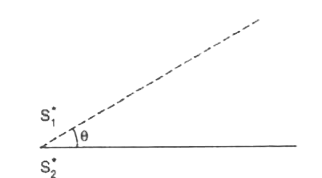If y=5(mm)sinπt is equation of oscillation of source S1 and y2=5(mm)sinπ/6) be that of S2 and it takes 1sec and ^(1/2sec for the transverse waves to reach point A from source S1 and S2 respectively then the resulting amplitude at point A, is
_S01_006_Q01.png) .Solution in Gujrati
.Solution in Gujrati
5√2+√3mm
5√3mm
5mm
5√2mm
The correct Answer is:C
Wave originating at t=0 from S1 reaches point A at t=1
Wave originating at t=12 from S2 reaches point A at t=1
So phase difference in these waves =π2+π6,A=√A21+A22+2A1A2cosϕ=5.
Topper's Solved these Questions
Similar Questions
The length , breadth , and thickness of a metal sheet are 4.234m,1.005m,and2.01cm, respectively. Give the area and volume of the sheet to the correct number of significant figures.
View SolutionThe energy of a photon of sodium light (λ=589nm)equal the band gap of a semiconducting material.(a)Find the minimum energy E requried to create a hole-electron pair.(b)Find the value of E/kTat a temperature of 300K.
View SolutionAt absolute zero temperature Si acts as ……..
View SolutionIf sum_(r=15)^(29)(cos(r(pi)/(2)+theta)=S_(1) and sum_(r=15)^(29)(sin(r(pi)/(2)+theta)=S_(2), then (S_(1))/(S_(2)) equals
View SolutionIf sum_(r=15)^(29)cos((r pi)/(2)+theta)=S_(1) and sum_(r=15)^(29)sin((r pi)/(2)+theta)=S_(2) then find the value of (s_(2))/(s_(1))
View SolutionThree sources of sound S_(1),S_(2) and S_(3) of equal intensity are placed in a straight line with S_(1)S_(2) = S_(2)S_(3) shown in the figure. At a point P, far away from the sources, the wave coming from S_(2) is 120^(@) ahead in phase of that from S_(1), Also, the wave coming from S_(3) is 120^(@) ahead of that from S_(2). What would be the resultant intensity of sound at P ?
View SolutionRatio waves originating from sources S_(1) and S_(2) having zero phase difference and common wavelength lambda will show completely destructive interference at a point P is S_(1)P-S_(2)P is
View SolutionTwo coherent sources S_(1) and S_(2) are situated as shown in figure. Here S_(1) is fixed but S_(2) is performing SHM with amplitude 2cm . Initially S_(2) is at right extem. At time t=(pi)/(2omega) (where omega= angular frequency of SHM) :
View SolutionThree coherent sources S_(1), S_(2)" and" S_(3) can throw light on a screen. With S_(1) switched on intensity at a point P on the screen was observed to be I. With only S_(2) on, intensity at P was 2I and when all three are switched on the intensity at P becomes zero. Intensity at P is I when S_(1)" and" S_(2) are kept on. Find the phase difference between the waves reaching at P from sources S_(1) "and" S_(3) .
View SolutionIn the case of light waves from two coherent sources S_(1) and S_(2) , there will be constructive interference at an arbitrary point P, the path difference S_(1)P - S_(2)P is
View Solutionधवनि की तीन स्त्रोत S1,S2 तथा एS3 क ही रेखा में रखे हुए है -S1S2=S2S3 है और तीनो एक ही त्रीवता की धवनि उत्पन कर रखे हुए है S1S2=S2S3 है और तीनो एक ही त्रीवता की धवनि उत्पन्न क्र रहे है इसी रेखा पर इन स्त्रोत से बहुत दूर के एक बिंदु P पर S2 से आती रंग S1 से आती तरंग से 120∘ आगे की कला पर है तथा S3 से आती तरंग S2 से आती रंग से 120∘ आगे की कला पर है P बिंदु पर धवनि की परिणामी त्रीवता क्या होगी

View Solutionदो कला - सम्बन्ध स्त्रोत S1 तथा S2 एक ही कला में तरंगदैर्घ्य λ की प्रकाश तरंगे उत्पन्न करते है तथा उनके बीच की दूरी 2λ है S2 से गुजरती और S1S2 पर लंबरेखा के बिंदुओं पर विचार करे | S2 से वह न्यूनतम दूरी निकाले जहाँ तीव्रता न्यूनतम हो ।
View SolutionTwo sources S1 and S2 separated 2.0 m, vibrate according to equation y1=0.03sinπt and y2=0.02sinπt where y1,y2 and t are in M.K.S unit. They send out waves of velocity 1.5 m/s. Calculate the amplitude of the resultant motion of the particle co-linear with S1 and S2 and located at a point to the left of S1.
View SolutionTwo coherent point sources S_(1) and S_(2) vibrating in phase emit light of wavelength lambda .The separation between the sources is 2 lambda .The smallest distance from S_(2) on a line passing through S_(2) and perpendicular to S_(1)S_(2) where a minimum intensity occurs is :
View Solution
Fig. Shows two coherent sources S1 and S2, emitting wavelength λ.The separation S1S2=1.51.S1 is ahead in phase by π2 relative to S2.The maxima occurs in a direction given by sin−1 of :
View SolutionIf S0,S1,S2,… are areas bounded by the x-axis and half-wave of the curve y=sinπ√x, then prove that S0,S1,S2,… are in A.P…
View Solution
